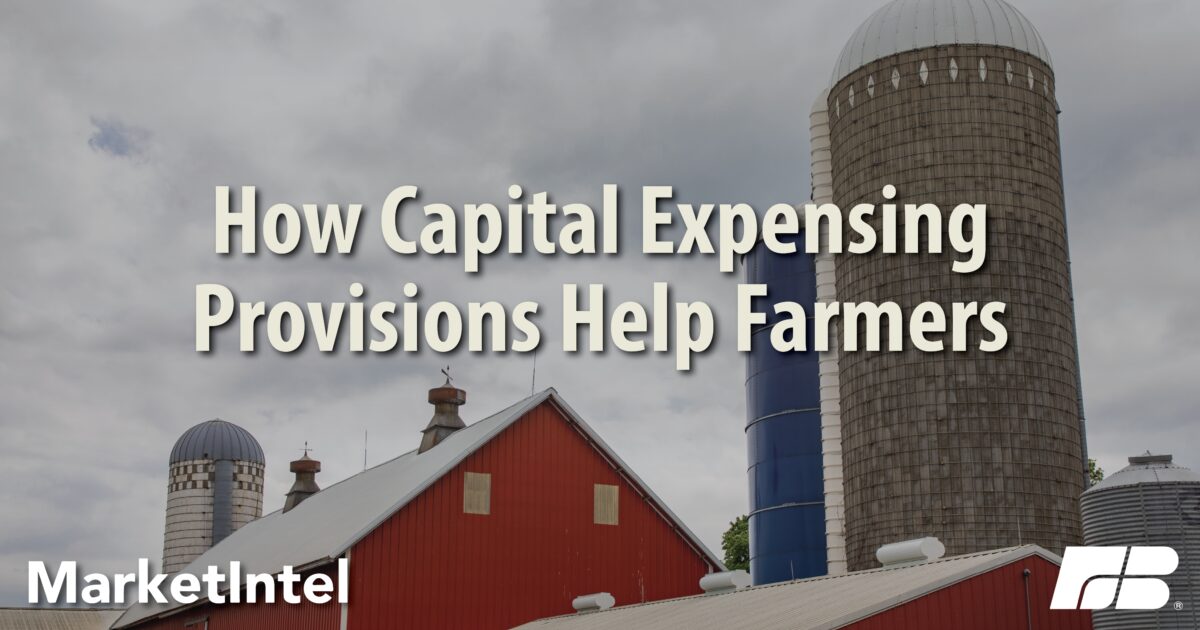The Dec. 31, 2025, expiration of many provisions of the 2017 Tax Cuts and Jobs Act (TCJA) adds a new task to the 2025 congressional to-do list: updating the tax code. Many TCJA provisions provided important relief for farm families. While reductions in the corporate income tax rates were made permanent in 2017, income tax cuts for individuals began to phase out in 2022, with the biggest tax increases coming with expirations at the end of 2025. This Market Intel report is the third in a series exploring the expiring TCJA provisions – including individual tax provisions, the qualified business income deduction, capital expensing provisions and estate taxes – and their impact on farm families.
Modern farming is capital intensive: farmers must constantly invest in land, machinery and technology. The cost of these assets continues to rise even as crop receipts stay low. For example, a Montana wheat farmer could buy a combine with a 20-foot head in 1975 for the value of 4,800 bushels, but a modern 40-foot class seven combine would cost 167,000 bushels today.
Costs for capital investments are traditionally excluded from operating costs used to calculate profits for tax purposes since these purchases add long-term value to the business. That means that farmers would typically pay taxes on the money they use to purchase assets. To recover some of the cost of these capital investments, farmers and ranchers can lower their tax liability by using two capital expensing deductions: Section 179 and bonus depreciation.
Why Expense?
Traditionally, asset value depreciates over a set time span, known as the class life, deducting a small portion of the asset’s value each year it is used. This accounting principle aims to match the value of the productive asset when it is used to the revenue it generates each year, balancing farm income and expenses. However, money – and assets – lose value over time due to inflation, so this effectively penalizes capital investments by preventing some of the initial purchase cost from ever being recovered. Under traditional depreciation requirements and a 2% inflation rate, business owners can only reclaim 78% of their asset’s value. So, that Montana farmer buying a combine in 2025 would only offset 130,260 bushels of their original purchase with slightly lowered tax bills over a longer time period.
Taxing the funds used for capital investment under traditional depreciation schedules hampers farmers’ and ranchers’ ability to make high-value investments in their operations, slowing their rate of innovation and improvements to agricultural production. The TCJA shortened the depreciation lifespan of farm equipment from seven years to five years, reducing the amount of value lost to future inflation. But with the high inflation we have experienced in recent years, assets lost value even quicker than in lower inflation periods, making the depreciation deduction less valuable and making it even more difficult to justify the costs of large capital investments without some way to recover the purchase costs.
The alternative to traditional class life depreciation is full business expensing which depreciates the entire cost of the asset the first year it is used. This reflects the upfront cost of purchasing the asset rather than the lifetime value. Expensing provisions are therefore known as “cost recovery” methods. Expensing, or cost recovery, prevents companies from paying taxes on “profits” that were actually spent on a business investment but do not qualify as costs under standard income adjustments. Section 179 and bonus depreciation lower the total cost of capital, expand business cash flow and encourage economic activity by incentivizing reinvestment of funds into a business.
Section 179 Deduction
The Section 179 expensing deduction is a capped deduction for small business investments. The TCJA permanently doubled the maximum Section 179 deduction from $500,000 to $1 million. Small business owners, including farmers and ranchers, can deduct up to $1 million (indexed for inflation) of new or used qualified business property purchases – including machinery, equipment, buildings or select vehicles – not including land or the cost of certain improvements to their existing assets – from their taxable income by claiming the Section 179 deduction in the year they begin using the asset.
Section 179 has two main restrictions. The deduction may not be used to create a business loss – meaning you can only deduct up to your total taxable business income, even if less than $1.25 million in 2025. Fortunately, if you are not able to take the full deduction in the first year you utilize an asset, you can retain a portion of the deduction value for future tax years, like a depreciation schedule.
Since this deduction is aimed at small businesses, it also does not apply for very large investments. One dollar is reduced from the maximum $1.25 million deduction for every dollar of qualified purchases over $3.13 million in 2025. No deduction can be taken for purchases of $4.38 million or more. However, even with these limits, farmers and ranchers may be able to recapture some of their investment using bonus depreciation.
Bonus Depreciation
For capital purchases above the deduction limit of Section 179, farmers and ranchers can deduct a portion of the cost using bonus depreciation, found in section 168(k) of the U.S. tax code. TCJA allowed full, 100% expensing regardless of purchase price through 2022. However, the percentage of an asset’s value eligible for bonus deprecation has been decreasing by 20% each year since the end of 2022. Therefore, in 2025, 40% of an investment’s purchase price may be deducted from this year’s taxes while the rest of the asset’s value must be depreciated over time. Accelerating any amount of first-year expensing saves some of the value that would typically be lost to inflation over a depreciation schedule, but lack of 100% expensing means farmers and ranchers will still lose a portion of their capital investments’ value. If TCJA provisions are not extended in 2025, bonus depreciation will expire at the end of 2026.
Bonus depreciation is not limited by the restrictions of Section 179. Farmers and ranchers can claim a deduction on any size purchase, and the deduction may even create a business income loss – showing more costs than revenues in a year with large capital investments and creating additional tax savings.
Bonus depreciation can immediately apply to all capital investments, but if a taxpayer elects not to claim the deduction, all purchases that year in the same depreciation class will not receive the deduction. Farmers and ranchers may elect to not claim the deduction to offset a portion of future revenues if they see increased tax liabilities over the course of the asset’s life.
Since bonus depreciation applies to larger purchases, fewer farms and ranches claim this deduction than the TCJA provisions outlined in previous Market Intel reports. However, the expiration of full (100%) bonus depreciation has large impacts on those farms that do claim the deduction. On average, for a farm that does claim bonus depreciation, their tax liability would jump by over $87,000 a year without the deduction. In total, that adds up to nearly $200 million a year in additional farm tax liabilities for farm and ranch families.
Capital Expensing Encourages Economic Growth
By providing incentives to business owners to grow their production, capital expensing measures create growth across the economy – in the farm or ranch spending their funds, in the manufacturers that will need more employees to build the combine or planter being purchased and higher wages for the construction workers that expand the factory or build a new tractor shed for the farmer. Each of those industries in turn can utilize the business expensing provisions to reinvest in their firms that are seeing increased production, building up the entire U.S. economy.
This was just part of the incentive to investment under the TCJA. Lower marginal tax rates in the TCJA also aided in lowering the total cost of capital. Since C corporations’ tax rates decreased the most under TCJA, C corporations used both expensing provisions at a higher rate than pass-throughs. The 199A deduction was even more crucial in providing available capital to incentivize business investment in pass-through entities that pay higher marginal tax rates than C corporations. For assets purchased on credit, capital expensing provisions may even be large enough to cause a negative effective tax rate, aiding farm financials overall by reducing tax expenses.
There is evidence that increased business investments from capital expensing provisions increase demand for labor and increase wages for those employees since businesses are able to expand their operations overall. The Tax Foundation estimates that permanent 100% bonus depreciation would create 87,000 full-time jobs in the U.S. Even permanent 80% bonus depreciation could create nearly 70,000 jobs and still generate significant capital investment. Since labor shortages persist throughout the economy, capital expensing also allows businesses to invest in automation technology, including in many agriculture sectors.
The Council of Economic Advisors estimated that TCJA expensing provisions would increase U.S. Gross Domestic Product (GDP) by 3.1%. Total growth since the passage of TCJA was likely lower than original estimates due to unforeseen circumstances such as supply chain disruptions during the COVID-19 pandemic and high interest rates to combat inflation. Even so, a return to 100% bonus depreciation in the 2025 tax package is still estimated to continue to boost long-run GDP by 0.4% beyond the growth since 2017.
Conclusion
Innovation and technology allow farmers to increase productivity, growing more food, fiber and fuel on less land, with less environmental impact. However, those innovations come with a cost: typically larger, more advanced technology with a price tag to match. As agriculture continues to advance, farmers and ranchers are faced with large capital investments to maintain their operations at the highest level of efficiency.
However, we have already seen the effects of uncertainty in agriculture on investment as we enter another year with lower crop returns and an outdated farm safety net. From 2024 to early 2025 tractor sales are down17% and combine sales down 48%. Capital expensing provisions can provide valuable relief for farmers and ranchers needing to make business investments while facing other financial uncertainties. Instead of having to forfeit the new combine due to a hefty tax bill in a year with extra revenue, Section 179 and bonus depreciation could allow the Montana wheat farmer flexibility to invest in the future of their farm.
Please consult a tax professional if you’d like to discuss the use of these deductions for your farm or ranch.







